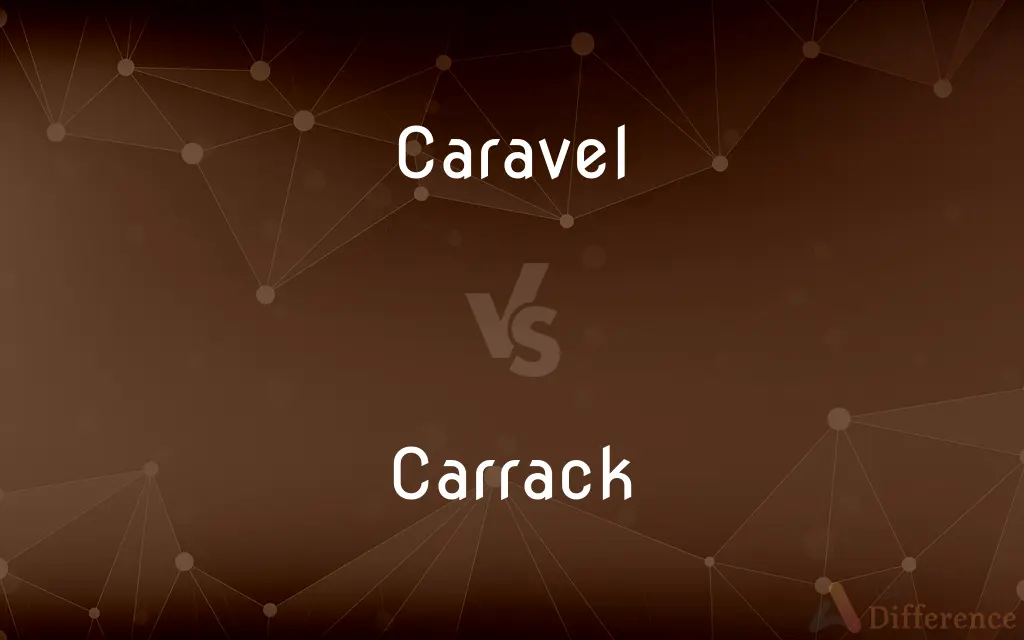Caravel vs. Carrack — What's the Difference?
By Urooj Arif & Maham Liaqat — Updated on March 19, 2024
Caravels are smaller, highly maneuverable sailing ships developed by the Portuguese in the 15th century for exploration, while carracks are larger, more robust ships used for longer voyages and cargo transport in the 15th and 16th centuries.

Difference Between Caravel and Carrack
Table of Contents
ADVERTISEMENT
Key Differences
Caravels were pivotal in early exploration, known for their speed, agility, and ability to sail close to the wind, making them ideal for navigating the uncharted waters of the Atlantic Ocean and the African coast. In contrast, carracks were larger, sturdier vessels designed to endure long sea voyages and carry substantial cargo. Characterized by their high castle-like structures at the bow and stern, carracks typically had three to four masts with a combination of square and lateen sails, providing both power and the ability to sail across and into the wind.
Caravels played a crucial role in the Age of Discovery, used by explorers like Vasco da Gama and Christopher Columbus, enabling the exploration of the Atlantic islands, the West African coast, and the oceanic route to the East. The design of caravels evolved to include both lateen-rigged and square-rigged versions, enhancing their versatility in different wind conditions. On the other hand, carracks, as the larger and more heavily armed predecessors to the galleon, were the ships of choice for long-distance trade missions, including those to the East Indies, and were instrumental in the establishment of European overseas empires.
The construction of caravels was such that they were lighter and required less draft, allowing them to navigate shallow waters and river estuaries, making them well-suited for exploration and coastal trade. Carracks, with their larger size and deeper draft, were more suited to the open ocean and capable of carrying more goods, crew, and armaments, making them the backbone of maritime commerce and naval fleets during their time.
Despite their differences, both caravels and carracks contributed significantly to the maritime advancements of the 15th and 16th centuries. The caravel's agility and speed made it a key player in the exploration of the world, while the carrack's capacity and durability facilitated the expansion of trade networks and the establishment of colonial territories.
Comparison Chart
Size
Smaller, lighter, and more maneuverable.
Larger, heavier, and designed for carrying substantial cargo.
ADVERTISEMENT
Mast/Sail Configuration
Two to three masts with lateen sails for maneuverability.
Three to four masts with a mix of square and lateen sails for power and versatility.
Use
Exploration and coastal trade.
Long voyages, oceanic trade, and naval engagements.
Notable Features
Ability to sail close to the wind, ideal for exploration.
High castles at bow and stern, sturdy construction for long voyages.
Historical Significance
Crucial in early explorations, including the Atlantic and African coasts.
Key to long-distance trade and the establishment of overseas empires.
Compare with Definitions
Caravel
Designed for exploration.
Caravels were used by Columbus to discover the New World.
Carrack
Built for long voyages.
Carracks carried spices and goods from Asia to Europe.
Caravel
Versatile sail configuration.
Caravels could change between square and lateen sails depending on conditions.
Carrack
Combination of sails.
The mix of sails gave carracks versatility in different wind conditions.
Caravel
Highly maneuverable.
The lateen sails of caravels allowed them to navigate through challenging winds and waters.
Carrack
Large cargo capacity.
Carracks were the workhorses of maritime trade, transporting vast quantities of goods.
Caravel
Smaller size.
Caravels could explore rivers and coastal regions inaccessible to larger ships.
Carrack
Sturdy construction.
Carracks' robust design made them reliable for transoceanic journeys.
Caravel
Key to the Age of Discovery.
Caravels were instrumental in mapping uncharted territories.
Carrack
Part of naval fleets.
Carracks were often armed and used in naval confrontations.
Caravel
The caravel (Portuguese: caravela, IPA: [kɐɾɐˈvɛlɐ]) is a small highly-maneuverable sailing ship developed in the 15th century by the Portuguese to explore along the West African coast and into the Atlantic Ocean. The lateen sails gave it speed and the capacity for sailing windward (beating).
Carrack
A carrack (Portuguese: nau, Spanish: nao, Catalan: carraca) is a three- or four-masted ocean-going sailing ship that was developed in the 14th to 15th centuries in Europe, most notably in Portugal. Evolved from the single-masted cog, the carrack was first used for European trade from the Mediterranean to the Baltic and quickly found use with the newly found wealth of the trade between Europe and Africa and then the trans-Atlantic trade with the Americas.
Caravel
Any of several types of small, light sailing ships, especially one with two to four masts and lateen sails used by the Spanish and Portuguese in the 1400s and 1500s.
Carrack
A large sailing vessel with a high forecastle and poop, used from the 1300s to the 1500s.
Caravel
A light, usually lateen-rigged sailing ship used by the Portuguese and Spanish for about 300 years from the 15th century, first for trade and later for voyages of exploration.
Carrack
(historical) A large European sailing vessel of the 14th to 17th centuries similar to a caravel but square-rigged on the foremast and mainmast and lateen-rigged on the mizzenmast.
Caravel
A name given to several kinds of vessels.
Carrack
See Carack.
Carrack
A large galleon sailed in the Mediterranean as a merchantman
Common Curiosities
What was the primary purpose of caravels?
Caravels were primarily used for exploration and coastal trade.
How did the design of caravels evolve?
The design of caravels evolved to include both lateen-rigged and square-rigged sails for versatility.
What made carracks suitable for long voyages?
Carracks were suitable for long voyages due to their sturdy construction and large cargo capacity.
How did carracks contribute to global trade?
Carracks facilitated long-distance trade, especially in spices and luxury goods from Asia to Europe.
Were carracks used in naval battles?
Yes, carracks were often armed and used in naval confrontations due to their size and strength.
Why were caravels so maneuverable?
Caravels' maneuverability was due to their lateen sails, which allowed them to sail close to the wind.
What role did carracks play in the establishment of colonies?
Carracks played a key role in establishing colonies by transporting settlers, goods, and armaments overseas.
Can caravels navigate shallow waters?
Yes, caravels could navigate shallow waters thanks to their lighter construction and smaller size.
How did caravels impact the Age of Discovery?
Caravels were instrumental in the Age of Discovery, enabling explorers to chart new territories and sea routes.
Did carracks and caravels coexist?
Yes, carracks and caravels coexisted and were used for different purposes during the 15th and 16th centuries.
Share Your Discovery

Previous Comparison
Rainforest vs. Grassland
Next Comparison
Jalapeno vs. HabaneroAuthor Spotlight
Written by
Urooj ArifUrooj is a skilled content writer at Ask Difference, known for her exceptional ability to simplify complex topics into engaging and informative content. With a passion for research and a flair for clear, concise writing, she consistently delivers articles that resonate with our diverse audience.
Co-written by
Maham Liaqat















































